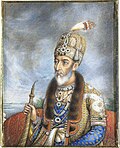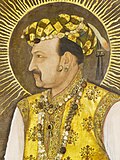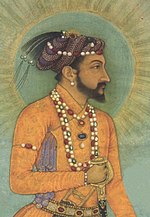during whose reign the religious policy of the Mughals were formulated. The later Mughals followed Akbar but violation of his policy went unabated many...
21 KB (2,937 words) - 06:10, 22 September 2024
the Mughals from the Indo-Gangetic Plains. Urged by Bairam Khan, who re-marshalled the Mughal army before Hemu could consolidate his position, Akbar marched...
150 KB (17,718 words) - 08:05, 9 October 2024
Din-i Ilahi (category Akbar)
Allopanishad Sirr-i-Akbar Majma-ul-Bahrain Dabestan-e Mazaheb Dara Shikoh Ganga-Jamuni tehzeeb Religious policy of the Mughals after Akbar "Din-i Ilahi". Britannica...
17 KB (1,800 words) - 15:05, 27 September 2024
method as the "Ottoman device" due to its previous use by the Ottomans during the Battle of Chaldiran. Religious policy of the Mughals after Akbar Satish...
34 KB (4,319 words) - 19:56, 18 September 2024
dated to 1600, to the rule of Babur's grandson, Akbar. This imperial structure lasted until 1720, until shortly after the death of the last major emperor...
170 KB (16,048 words) - 12:46, 14 October 2024
Alam, repealed the religious policies of his father and attempted to reform the administration. "However, after his death in 1712, the Mughal dynasty sank...
30 KB (2,059 words) - 04:56, 13 October 2024
during which the Mughals successfully captured the fort of Chittorgarh after a hard-pressed siege which lasted for several months. Akbar under his expansionist...
21 KB (2,637 words) - 11:56, 8 October 2024
Mariam-uz-Zamani (category Wives of Akbar)
religious and social policies. She is widely regarded in modern Indian historiography as exemplifying both Akbar's tolerance of religious differences and their...
109 KB (14,096 words) - 16:53, 7 October 2024
Akbar II (Persian pronunciation: [ak.baɾ]; 22 April 1760 – 28 September 1837), also known as Akbar Shah II, was the nineteenth Mughal emperor from 1806...
10 KB (944 words) - 13:58, 11 October 2024
Empire. Subsequently Mughals and Rajputs established a peaceful relation with Emperor Akbar accepting many Rajput leaders into Mughal court and giving them...
21 KB (2,337 words) - 14:57, 11 October 2024
ruling family of a small principality to both collaborate with the Mughals and rebel. In 1681, Sambhaji was contacted by Prince Akbar, the Mughal emperor Aurangzeb's...
110 KB (12,947 words) - 17:07, 18 September 2024
Sultanat to the Mughals. Vol. I. Har-Anand Publications. ISBN 978-81-241-0522-1. Chandra, Satish (1993). Mughal Religious Policies, the Rajputs & the Deccan...
208 KB (22,715 words) - 19:52, 13 October 2024
Man Singh I (redirect from Man Singh I of Amber)
Pratap, who escaped to the hills. In 1580 CE, some prominent Muslim officers of Akbar, displeased with his liberal religious policies, started to conspire...
24 KB (2,942 words) - 04:27, 14 October 2024
Birbal (redirect from Akbar and Birbal stories)
and Birbal was not the cause. Historically, he was more of a supporter of Akbar's religious policy and his religion, Din-i-Ilahi. Akbar and Birbal folk tales...
21 KB (2,242 words) - 19:00, 11 October 2024
Jahangir (redirect from Jahangir, Emperor of Hindustan, 1569-1627)
saw the delight Akbar held for them, sent for more and more of the same to be given to the Mughals. They felt the Mughals were on the "verge of conversion"...
76 KB (8,972 words) - 10:23, 14 October 2024
Aurangzeb (redirect from Decline of Emperor Aurangzeb)
emperorship, Mughal Empire reached its greatest extent with territory spanning nearly the entirety of the Indian subcontinent. Aurangzeb and the Mughals belonged...
178 KB (20,450 words) - 12:59, 14 October 2024
Sambhaji (category 17th-century executions by the Mughal Empire)
with the Mughals on 11 June 1665. As a result of the treaty, Sambhaji became a Mughal mansabdar. He and his father Shivaji attended the Mughal emperor...
41 KB (4,593 words) - 11:44, 5 October 2024
the Mughal Empire to include a large portion of the subcontinent. Under Akbar, who stressed the importance of religious tolerance and winning over the goodwill...
176 KB (21,103 words) - 10:07, 6 October 2024
Mirza (name) (redirect from Line of succession to the Mughal throne)
the various Persian Empires, the Nogai Horde, Shirvanshahs and Circassians of the European Caucasus, the Mughals / Moguls and Muslim Rajputs of the Indian...
26 KB (2,768 words) - 16:42, 28 September 2024
Shah Jahan (category Emperors of the Mughal Empire)
during the Mughal campaign against the Rajput state of Mewar, which had been a hostile force to the Mughals since Akbar's reign. After a year of a harsh...
70 KB (7,635 words) - 04:15, 10 October 2024
Shah Alam II (category Emperors of the Mughal Empire)
against Mughal intolerance specially after beheading of the Sikh Guru - Guru Teg Bahadur by the Mughals. Simmering Sikhs rose once again in the year 1764...
42 KB (4,773 words) - 09:46, 7 October 2024
Political marriages in India (redirect from Rajput Mughal marriage alliances)
Rajput rulers provided the brides to the Mughals, neither Akbar nor his successors provided brides to the Rajputs. For example, Akbar got this sisters and...
51 KB (5,568 words) - 11:04, 14 October 2024
ʽAbd al-Qadir Badayuni (category Akbar)
Muslim mystics. The Mughal emperor, Akbar, appointed him to the religious office in the royal courts in 1574 where he spent much of his career. Badayuni...
7 KB (533 words) - 09:24, 6 October 2024
Gunpowder empires (redirect from Period of the Gunpowder Empires)
the vanguard of the Mughal cavalry. The Mughal Empire became a powerful geopolitical entity with at times, 24.2% of the world population. The Mughals...
39 KB (4,898 words) - 10:30, 13 October 2024
Bharmal (category Maharajas of Jaipur)
Mughal Emperor, Akbar and mother of the 4th Mughal Emperor Jahangir. His daughter's marriage to Akbar was a significant event of the Mughal Empire. He along...
13 KB (1,340 words) - 10:53, 12 October 2024
the other hand, rulers such as Akbar adopted a secular legal system and enforced religious neutrality. Muslim rule in India saw a major shift in the cultural...
46 KB (4,973 words) - 11:44, 4 October 2024
Lahore Fort (redirect from The Lahore Fort)
the era of Emperor Akbar. The Lahore Fort is notable for having been almost entirely rebuilt in the 17th century, when the Mughal Empire was at the height...
48 KB (5,486 words) - 20:40, 20 September 2024
urbanisation of the Mughal Empire to be less than 9% of the population. Under the reign of Akbar (reigned 1556–1605) in 1600, the Mughal Empire's urban...
217 KB (6,470 words) - 10:52, 6 October 2024
Syncretism (category Wikipedia articles incorporating a citation from the 1911 Encyclopaedia Britannica with Wikisource reference)
by Akbar himself. It is also accepted that the policy of sulh-i-kul, which formed the essence of the Dīn-i Ilāhī, was adopted by Akbar as a part of general...
19 KB (2,110 words) - 15:48, 30 July 2024
Jharokha Darshan (category Government of the Mughal Empire)
greeted Akbar when he appeared on the jharokha window for sun worship. It was also the period when Akbar was promoting his liberal religious policy, and...
18 KB (2,174 words) - 01:28, 10 October 2024




























